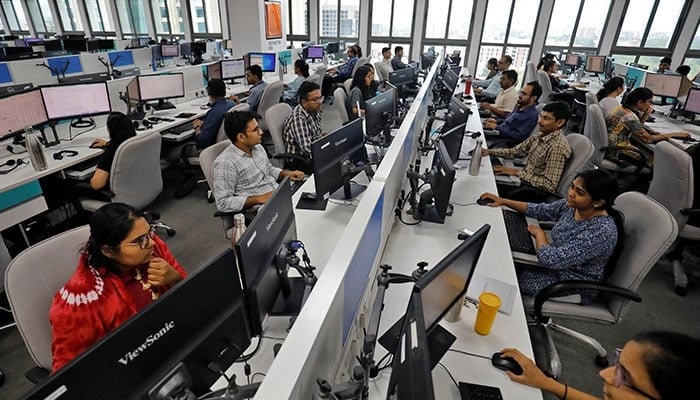Are we benching the best?
The assumption that people become unproductive past a certain age is not backed by evidence
July 30, 2025

The old idea of retirement, clocking out at 60 or 65, was built in an era when most people didn’t live much longer than that. It made sense then: a few years of rest after a life of labour.
However, lifespans have expanded dramatically today. Many people live well into their 80s, often in reasonably good health. Yet institutions, especially in countries like Pakistan, still treat ageing as a shutdown signal rather than a transition into another productive phase. This rigid mindset no longer serves individuals, economies or societies.
The assumption that people become unproductive past a certain age is not backed by evidence. While some physical slowing is natural, cognitive abilities like judgment, strategic thinking, emotional intelligence and creativity often improve with age. Experience matters – especially in fields like education, governance, research and public service.
Many global leaders and thinkers have continued to contribute well into their later years. Think of Lee Kuan Yew, still shaping Singapore’s strategic thinking into his 80s, or Warren Buffett, making high-stakes investment decisions in his 90s. The issue isn’t age – it’s how institutions harness age.
For Pakistan and other developing countries, this debate has another critical dimension: the demographic dividend. For years, we’ve heard that a youth bulge – an expanding working-age population – can be a source of accelerated growth. But this dividend doesn’t just fall into our lap. Without institutional reform, job creation, and innovation, it becomes a missed opportunity.
Now, with rising life expectancies, there's a possibility of a second demographic dividend – one powered by experienced adults who continue to work, mentor, save and invest into their 60s and 70s. These mature contributors, when productively engaged, can enhance national savings, intergenerational knowledge transfers and economic stability. But this can only happen if systems evolve to support longer, more flexible work lives.
Yet here lies the tension: in a country full of energetic youth seeking opportunities, can older individuals continue to hold on to senior positions without blocking upward mobility? Answer: redesign work and leadership to create mobility, not rigidity. Leadership roles – whether in academia, government, or corporate life – must not become lifetime entitlements.
These positions need clear term limits. Fixed tenures for vice chancellors, secretaries, directors and CEOs would allow for continuity without creating bottlenecks. At the end of their term, individuals should be encouraged – through policy and prestige – to transition into mentorship, advisory, or second-career roles.
There’s no reason someone at 65 cannot lead a think tank, teach a leadership course, guide startups or serve on reform commissions. But the nature of their engagement must change. Leadership should be dynamic, not monopolised.
In Pakistan, almost every job advertisement comes with a hard age limit – often under 60, and sometimes as low as 45 or 50. This systemic exclusion of older individuals is both irrational and wasteful. Why discard human capital precisely when it has the most to offer in terms of experience and maturity?
Part of the problem is the widespread belief that youth can only be given a chance if the old step aside. But this is a false dichotomy. We don't need to rotate a fixed number of chairs; we need to build more chairs. The answer lies in expanding the economy, growing new sectors, fostering entrepreneurship and creating more employment opportunities for all age groups, not just reallocating the same handful of positions.
Strangely, this obsession with age limits does not apply to politics. One can be elected prime minister at 75 or president at 80, without any upper limit. Yet for civil servants, professors, engineers and countless other professionals, employment is forcibly terminated at 60.
What explains this inconsistency? Both are selected for public service, one by vote and the other by technical expertise. Surely, if voters trust an 80-year-old with national leadership, an institution can trust a 65-year-old with teaching or technical advice. If anything, technical roles demand more continuous learning and up-to-date expertise. Age limits should not be arbitrary – they should reflect performance, not prejudice.
Globally, many countries have already moved away from mandatory retirement and opened the door to meaningful second careers. The US abolished compulsory retirement in most fields in 1986. Canada phased it out province by province from the 1970s through 2009.
Australia made age discrimination illegal and eliminated default retirement ages by 2004. New Zealand gradually banned mandatory retirement between the 1990s and early 2000s – all as part of broader strategies to support ageing workforces.
OECD guidance now recommends ending compulsory retirement age rules and strengthening protections for older workers (GOV.UK). These reforms are part of coordinated packages – raising pension ages, combating age discrimination, offering retraining – all aimed at linking longer careers to sustainable career paths.
It is important to build structures that facilitate second careers. Too often, retirement is treated as a disappearance. Instead, people should be allowed – and encouraged – to pivot into new roles.
An engineer can become a mentor or educator. A retired bureaucrat can join a policy review commission. A former CEO can advise a young startup or help build capacity in a government agency. This requires institutional imagination. Governments and private firms should fund fellowships and platforms that help retirees retrain, reposition and reengage.
The country would benefit greatly from a national mentor programme that mobilises experienced professionals after retirement. These individuals could serve in universities, think tanks and policymaking bodies as advisers, trainers and mentors.
By embedding seasoned experts in public institutions, academia and reform programmes, we could create a knowledge loop between generations – enhancing learning, avoiding policy mistakes and grounding decision-making in real-world experience. This is not charity or nostalgia; it is economic sense and good governance.
It’s not just about old people working longer. It’s about designing work systems that are fair, flexible and future-oriented. Intergenerational equity demands that while older individuals remain engaged, they must not clog the system.
Leadership pipelines should flow. Young professionals should be fast-tracked into meaningful roles. Middle-aged workers should be able to pivot and grow. Older professionals should transition into mentorship and legacy roles without being pushed out entirely.
Finally, ageing should not mean exit. Retirement should not be a cliff. And leadership should not be a throne. If we are to adapt to longer lives, we must adjust the way we think about work.
Let’s make room for youth, respect the wisdom of age, and build institutions where tenure is limited, performance is rewarded and experience is rechanneled, not discarded. A second demographic dividend is within reach. But only if we design for it.
The writer is a former deputy chairman of the Planning Commission. He tweets/posts @Nadeemhaque and his Youtube account is @SIAlytics
Disclaimer: The viewpoints expressed in this piece are the writer's own and don't necessarily reflect Geo.tv's editorial policy.
Originally published in The News









